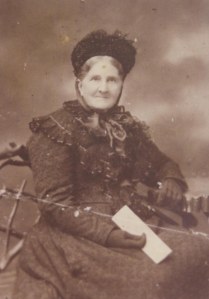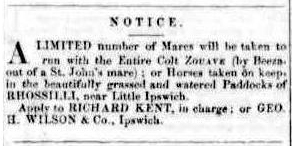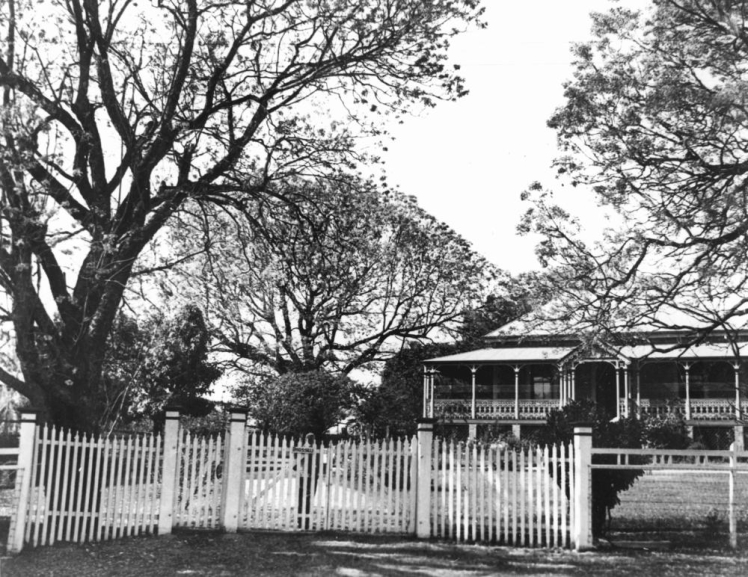The 2013 Australia Day challenge was initiated by Helen of the blog From Helen V Smith’s Keyboard. The challenge is to talk about our first ancestors to arrive in Australia, male or female, or perhaps both. My initial reaction hovered around my “swimmers” George Kunkel and his wife Mary O’Brien. While George may have been part of the Victorian gold rush fever, it’s by no means certain, so in the end I decided to go with my earliest identified arrivals. This neatly captured both my great-great-great grandparents, Richard and Mary Kent, but also my great-great-grandmother, their daughter Hannah, who would later marry William Partridge in Ipswich, Queensland.

Richard and Mary Kent arrived at Moreton Bay with their adult children on 16 December 1854 on board the General Hewitt. Richard Kent (46) was an agricultural labourer whose parents were Richard and Mary Kent, both deceased. Mary Kent was 49 and her parents, John and Mary Camp, were both deceased. Also among the married couples was their son Richard Kent (23) with his wife Mary Kent (23) and daughter Catherine Kent (1). The younger Richard was also an agricultural labourer and of course his parents were on board. His wife’s parents were Samuel and Mary Brittain who were both living in Cambridge. Listed among the single passengers were the older Richard and Mary’s other adult children: Hannah Kent, aged 19 was a servant whose parents were on board; Thomas Kent (19) and John Kent (17) both agricultural labourers. All the members of the family are recorded, not entirely accurately, as born in Hertfordshire. All could read and write except Mary Brittain Kent and John Kent who could read only. They all stated their religion as Church of England.[1] .

The immigrants on the General Hewitt, a ship of 965 tons, had sailed from Southampton on 25 August 1854 and arrived in Moreton Bay 107 days later. There had been 16 deaths on board (14 of them children) and 3 births. The brig Sporting Lass went down to the Bay to bring the passengers up to town but the weather was so rough it prevented the brig from lying alongside. After such a long time at sea, the immigrants had a frustrating week waiting to be taken ashore.[2] As they landed only days before Christmas I wonder what how they felt to be in such a different environment.
On arrival 381 immigrants were disembarked and the newspapers report that there was such demand for labour that less than two weeks later there were only 70 adults remaining in the immigration barracks and most of them were hired.[3] The Kents were among the large groups of agricultural labourers and servants looking for work. Presumably they were recruited by an Ipswich employer because this is where they settled. Wages for a married couple were £50 and for female servants £20.
The Kent family came from the village of Sandon in Hertfordshire which had been the family’s home for hundreds of years. In the 1851 census Richard Kent (46) was enumerated at Roe Green near Sandon as a farmer of 40 acres (employing one man) and a beer house keeper.[4] His wife Mary was 50 and their sons, Thomas 17 and John 15, were employed at home. All of the family were born in Sandon. Roe Green is an old medieval settlement and I wrote about my discovery of their pub’s name and more about it here.[5]

In 1851, Richard and Mary’s daughter Hannah (my great-great-grandmother-to-be) was 14 and a servant working for Mrs Anne Field at Wood Farm, in the adjacent parish of Rushden. Wood Farm has a long history, being an old moated site from the 16th century. Their eldest son, Richard Kent (21) and his wife Mary Ann Kent née Brittain (21) were living at Green End in Sandon where Richard was working as an agricultural labourer. Mary Ann Brittain’s home place is recorded as Melbourn, Cambridgeshire, not Sandon. It is interesting to compare the family’s ages with the stated ages on arrival compared to their actual ages: Richard 46 (actually 49), Mary 49 (53), Richard jnr 23 (24), Mary Ann 23 (24), Hannah 19 (17), Thomas 19 (20) and John 17 (18). Hence all their ages, except Hannah’s, were decreased to enhance their immigration prospects and reduce costs.
An 1851 Post office directory for Hertfordshire confirms that Richard Kent was a beer retailer.[6] The village of Sandon was not a large one, though the parish is a little spread out and in 1851 there were 176 houses with a population of 770 (412 men and 358 women). It seems that the Kents were reasonably well established though not affluent. One wonders why the whole family decided to emigrate and re-establish themselves in MoretonBay. I think their reasons were either economic or to help the adult children get ahead. At one time I thought it may also have been attributable to religious affiliation as in Queensland there were occasional non-conformist links. I now suspect this was not the case.
Richard Kent’s name appears on various electoral rolls and on endorsements of nominees for parliamentary positions in Queensland. Apart from that he seems to have kept a fairly low profile in his new town and without any oral history it is difficult to develop a more holistic understanding of Richard or his wife Mary Kent.

Trove has helped me to unearth a clue to the family’s early life in Ipswich with several advertisements throughout 1856, thanks to the recent digitisation of the Ipswich newspapers. Richard Kent was working on Rhossili/Rhossilli, a property in Little Ipswich (now the edge of West Ipswich) where he is listed as “in charge” of stock. Whether this Richard was the father, who had run a farm as well as his public house, or the son who had worked as a farm labourer, is nigh on impossible to know. I like the fact that whichever man it was, had the opportunity to work with skills he’d acquired in England. Perhaps it was even his first contract on arrival in Queensland less than two years earlier.

My search for Rhossili in Trove revealed that around this time it was lived in by Pollett Cardew, Commissioner of the Peace. Ipswich Heritage lists a property called Rhossili but states it’s unclear whether this is the first property of that name. My ambivalence rests on the fact that this Rhossili is in Newtown, to the east of the city centre, whereas Little Ipswich was to the west. Conversely, Cardew is mentioned in association with the Ipswich Heritage site, in Pugh’s Almanac and in Trove family notices from 1857. Obviously there’s scope for future research at Queensland archives and libraries now I’m aware of the family connection.
The family’s hopes for a promising new life disappeared with the early deaths of children and grandchildren, leaving the succession limited mainly to the women in the line. On such genetic whims of matrilineal inheritance does my own existence depend.
Richard Kent died, aged 65, on 31 July 1870 at his residence at Pelican Street, North Ipswich. Richard’s place of birth is correctly stated as Red Hill (Sandon).[7] He was buried in the Ipswich cemetery by the Church of England minister. His wife, Mary Kent, died aged 75, only a few months later on 26 September 1870 at Terrace Street, NorthIpswich, the home of her daughter Hannah Partridge. Plainly her age had been routinely under-stated in the records. Her place of birth is stated as Weston (not Sandon), Hereford (actually Hertfordshire).
© Pauleen Cass
[1] State Records of NSW, Persons on Bounty ships to Sydney, Newcastle, MoretonBay 1848-1866. CGS 5317, microfilm 2466, reference 4/4937.
[2] The Moreton Bay Courier, 23 December 1854, page 2.
[3] The Moreton Bay Courier, 30 December 1854, page 2.
[4] 1851 English census, Hertfordshire, Registration district of Royston, Sub-registration district of Buntingford, parish of Sandon, HO107.
[6] Post Office Directory Hertfordshire, 1851,village of Sandon, page 222, digitised by Archive CD Books.
[7]Queensland death certificate 1870/C490. His county of birth is shown as Herefordshire not Hertfordshire, a mistake which was repeated on Mary Kent’s death certificate.
An interesting history… let’s hope even more is revealed as more papers are digitised. Thank you for sharing…
Happy Australia Day…
LikeLike
Thanks Chris….I’m thinking that a page-by-page investigation of the early Ipswich papers (a la microfilm but digitally) might be merited. With surnames like Kent and Partridge, it can be a challenge to find the needle in they haystack, not to mention the OCR-unfriendly Kunkel. Wish me luck 🙂
LikeLike
A well-researched family Pauleen – and a few gaps in your knowledge still to check. It’s fun isn’t it.
Happy Australia Day.
LikeLike
There’s always one more gap, and hopefully lots more clues to unearth _I guess that’s why it is so much Lorraine…couldn’t agree more.
LikeLike
A very interesting post, Pauleen, I enjoyed it. I was especially intrigued by the ‘massaging’ of the family’s ages. Oh, the things our ancestors did to confuse us and keep us on our toes.
Happy Australia Day!
LikeLike
Thanks Frances!
LikeLike
Laughed about your reference to “swimmers” Pauleen… I’ve got a few of those too 🙂 It’s most interesting how, in the 1850’s, various colonies seemed to be vying with each other to attract, and retain, Ag Labs. Reckon that Qld may have had similar problems to South Australia with so many Ag Labs scarpering off to try their luck on the Goldfields of NSW and Victoria.
I’m also fascinated with just how many whole families often migrated together… i.e. the adult children and their offspring with the parents/grandparents, etc. as your Kent family did. I’ve got quite a few of those too… SNAP! 🙂
Love your photo of “Sandon Church and the old Six Bells public house” …Great info, and research Pauleen… thanks for sharing.
LikeLike
Thanks for your comments Catherine. Yes they were all in competition. Given Qld’s weather I suppose it’s surprising more didn’t move on but I’m a ridgy didge Queenslander as the only one to migrate interstate was my confectioner -and only later in life. Apart from families, those chain migrations were pretty impressive too. The story goes my George Kunkel jumped ship for the goldfields and I spent ages searching deserters’ lists but then again it’s a very common family story. He may have done so since he later worked on the goldfields in northern NSW while his wife looked after the kids at home.
LikeLike
I’m feeling guilty about my post now because I took out the references because I was in a hurry to post and away from home. Think I will have to go back and fix up.
LikeLike
We are all so critical of ourselves, Sharon. I wouldn’t worry about it too much -you know what they are. I was mainly copying this from something I’d written for Q150 so didn’t have to think too hard about the refs.
LikeLike
A thought provking challenge for Austrlaia Day and this was such a fascinating, well researched story. I particularly liked the photograph of Hannah (Kent).Partridge .
LikeLike
Thanks Sue. I did much of the research a while ago which made it easier.
LikeLike